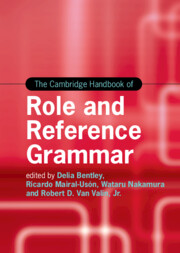Book contents
- The Cambridge Handbook of Role and Reference Grammar
- Cambridge Handbooks in Language and Linguistics
- The Cambridge Handbook of Role and Reference Grammar
- Copyright page
- Dedication
- Contents
- Figures
- Tables
- Contributors
- Pedagogical Guide to The Cambridge Handbook of Role and Reference Grammar
- Introduction
- Part One Overview
- Part Two Topics in RRG: Simple Sentences
- Part Three Topics in RRG: Complex Sentences
- 13 The Structure and Semantics of Complex Sentences
- 14 Linking Syntax and Semantics in Adverbial (Adjoined) Clauses
- 15 Cleft Sentences and Relative Clauses
- 16 Extraction Restrictions in Complex Sentences
- Part Four Applications of RRG
- Part Five Grammatical Sketches
- Index
- References
14 - Linking Syntax and Semantics in Adverbial (Adjoined) Clauses
from Part Three - Topics in RRG: Complex Sentences
Published online by Cambridge University Press: 08 June 2023
- The Cambridge Handbook of Role and Reference Grammar
- Cambridge Handbooks in Language and Linguistics
- The Cambridge Handbook of Role and Reference Grammar
- Copyright page
- Dedication
- Contents
- Figures
- Tables
- Contributors
- Pedagogical Guide to The Cambridge Handbook of Role and Reference Grammar
- Introduction
- Part One Overview
- Part Two Topics in RRG: Simple Sentences
- Part Three Topics in RRG: Complex Sentences
- 13 The Structure and Semantics of Complex Sentences
- 14 Linking Syntax and Semantics in Adverbial (Adjoined) Clauses
- 15 Cleft Sentences and Relative Clauses
- 16 Extraction Restrictions in Complex Sentences
- Part Four Applications of RRG
- Part Five Grammatical Sketches
- Index
- References
Summary
The goal of this chapter is to examine the rules that relate syntactic and semantic representations to each other in adverbial (adjoined) clauses. The following types of adverbial clause relations are discussed, using evidence from English, Spanish, Yaqui and other languages: concessive, conditional, reason, temporal, purpose, manner and means. The chapter sheds light on the complexities of adverbial relations between clauses and how such complexities can be captured in Role and Reference Grammar.
- Type
- Chapter
- Information
- The Cambridge Handbook of Role and Reference Grammar , pp. 557 - 590Publisher: Cambridge University PressPrint publication year: 2023



